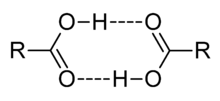Van 't Hoff factor
The van 't Hoff factor  (named after J. H. van 't Hoff) is a measure of the effect of a solute upon colligative properties such as osmotic pressure, relative lowering in vapor pressure, elevation of boiling point and freezing point depression. The van 't Hoff factor is the ratio between the actual concentration of particles produced when the substance is dissolved, and the concentration of a substance as calculated from its mass. For most non-electrolytes dissolved in water, the van' t Hoff factor is essentially 1. For most ionic compounds dissolved in water, the van 't Hoff factor is equal to the number of discrete ions in a formula unit of the substance. This is true for ideal solutions only, as occasionally ion pairing occurs in solution. At a given instant a small percentage of the ions are paired and count as a single particle. Ion pairing occurs to some extent in all electrolyte solutions. This causes deviation from the van 't Hoff factor. The deviation for the van 't Hoff factor tends to be greatest where the ions have multiple charges.
(named after J. H. van 't Hoff) is a measure of the effect of a solute upon colligative properties such as osmotic pressure, relative lowering in vapor pressure, elevation of boiling point and freezing point depression. The van 't Hoff factor is the ratio between the actual concentration of particles produced when the substance is dissolved, and the concentration of a substance as calculated from its mass. For most non-electrolytes dissolved in water, the van' t Hoff factor is essentially 1. For most ionic compounds dissolved in water, the van 't Hoff factor is equal to the number of discrete ions in a formula unit of the substance. This is true for ideal solutions only, as occasionally ion pairing occurs in solution. At a given instant a small percentage of the ions are paired and count as a single particle. Ion pairing occurs to some extent in all electrolyte solutions. This causes deviation from the van 't Hoff factor. The deviation for the van 't Hoff factor tends to be greatest where the ions have multiple charges.
Dissociated solutes
The degree of dissociation is the fraction of the original solute molecules that have dissociated. It is usually indicated by the Greek symbol  . There is a simple relationship between this parameter and the van't Hoff factor. If a fraction
. There is a simple relationship between this parameter and the van't Hoff factor. If a fraction  of the solute dissociates into
of the solute dissociates into  ions, then
ions, then
For example, the dissociation
- KCl
 K+ + Cl−
K+ + Cl−
- KCl
yields  particles, so that
particles, so that 
Associated solutes
Similarly, if a fraction  of
of  moles of solute associate to form one mole of an n-mer (dimer, trimer, etc.), then
moles of solute associate to form one mole of an n-mer (dimer, trimer, etc.), then
For the dimerisation of acetic acid in benzene
- 2CH3COOH
 (CH3COOH)2
(CH3COOH)2
- 2CH3COOH
2 moles of acetic acid associate to form 1 mole of dimer, so that
Physical significance of 

- When solute particles associate in solution,
 is less than 1. For example, carboxylic acids such as ethanoic acid (acetic acid) or benzoic acid form dimers in benzene, so that the number of solute particles is half the number of acid molecules.
is less than 1. For example, carboxylic acids such as ethanoic acid (acetic acid) or benzoic acid form dimers in benzene, so that the number of solute particles is half the number of acid molecules.
- When solute particles dissociate in solution,
 is greater than 1. (e.g. sodium chloride in water, potassium chloride in water, magnesium chloride in water)
is greater than 1. (e.g. sodium chloride in water, potassium chloride in water, magnesium chloride in water) - When solute particles neither dissociate nor associate in solution,
 equals 1. (e.g. Glucose in water)
equals 1. (e.g. Glucose in water)
The value of  is ;
is ;
 = the actual number of particles in solution after dissociation ÷ the number of formula units initially dissolved in solution.
Means the number of particles per formula unit of the solute when a solution is dilute.
= the actual number of particles in solution after dissociation ÷ the number of formula units initially dissolved in solution.
Means the number of particles per formula unit of the solute when a solution is dilute.
- Association of Molecules (i<1)



